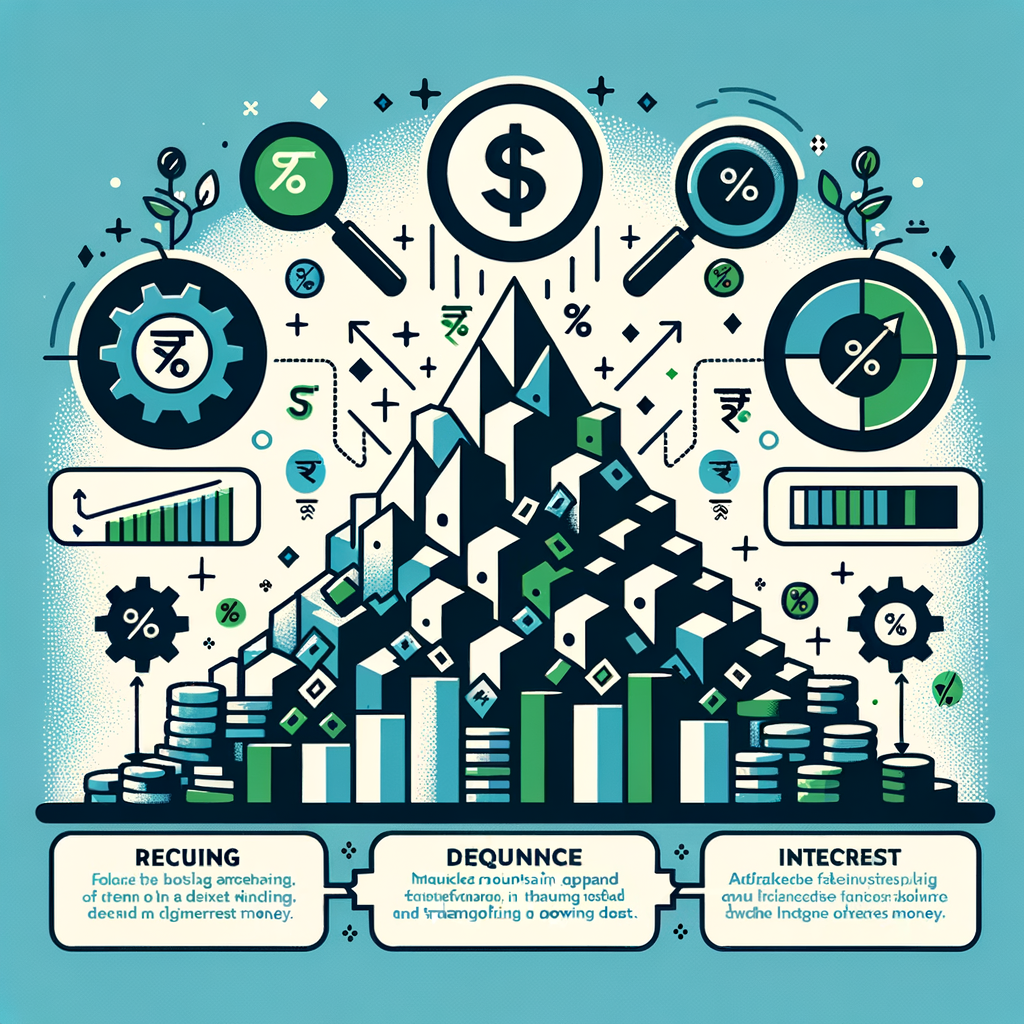How the Debt Avalanche Method Saves You Money on Interest in India
Juggling a credit card bill, a personal loan, and a car EMI can feel overwhelming for anyone, whether you’re a salaried professional or running your own small business. The high interest payments often feel like you’re running on a treadmill—working hard but not getting any closer to your financial goals. High-interest debt is a significant financial drain for many Indians, slowing down wealth creation and the path to true financial freedom. This is where a disciplined and mathematically sound strategy comes into play. By using the debt avalanche method, you can tackle your loans efficiently and systematically. This guide will break down exactly what this powerful method is, how it works, and how you can implement it to save significant money on interest. It’s one of the best personal finance tips India has for becoming debt-free.
What is the Debt Avalanche Method? A Simple Explanation
The core concept behind this effective strategy is remarkably simple, which is key to understanding debt avalanche method India. Instead of feeling scattered by trying to pay a little extra on all your loans, you focus your financial firepower on one target at a time. This method prioritizes your debts based on their interest rates, not their balances. The logic is to eliminate the most expensive debt first, which in turn saves you the maximum amount of money over the long run. By systematically attacking the loans that cost you the most in interest, you reduce the overall financial burden and accelerate your journey out of debt. This structured approach provides clarity and a clear path forward, transforming a chaotic debt situation into a manageable project with a definite end goal.
The Core Principle: Attack High-Interest Debt First
The logic of the debt avalanche method is straightforward: you continue to make the minimum required payments on all your outstanding debts, but you allocate every single extra rupee you can find in your budget towards the loan with the highest Annual Percentage Rate (APR). Think of it like a firefighter putting out the biggest fire first. High-interest debt causes the most financial “damage” over time through compounding, so you must extinguish it with absolute priority to prevent it from spreading and consuming more of your income. In India, some of the most common high-interest debts that can be tackled with this method include:
- Credit Card Debt: Often the most expensive, with annual interest rates ranging from 18% to a staggering 42%.
- Personal Loans: These are typically unsecured and can carry interest rates from 11% to 24% per annum.
- Unsecured Business Loans: Small business owners might have loans with high rates that can severely impact cash flow.
Debt Avalanche vs. Debt Snowball: Which is Better for Indians?
When exploring debt reduction methods for Indians, you will often encounter another popular strategy: the Debt Snowball Method. The key difference lies in the priority. The Debt Snowball method involves paying off the loan with the smallest outstanding balance first, regardless of its interest rate. The goal here is psychological; clearing a small debt quickly provides a motivational “win” that encourages you to keep going. While this can be effective for people who need that early boost, the debt avalanche method is mathematically superior. For a deeper analysis, read our complete guide on Debt Snowball vs. Debt Avalanche: Which Strategy Is Best for You?.
Here is a simple comparison to help you decide:
| Feature | Debt Avalanche Method | Debt Snowball Method |
|---|---|---|
| Priority | Highest Interest Rate Debt | Smallest Debt Balance |
| Advantage | Saves the most money on interest | Provides quick motivation |
| Best For | People who are disciplined and logic-driven | People who need early wins to stay on track |
Both strategies will help you get out of debt faster than just making minimum payments. However, if your primary goal is to save the most money possible and you can stay disciplined without needing quick psychological victories, the debt avalanche is the clear winner for your financial health.
Your Step-by-Step Guide to Implementing the Debt Avalanche Method
Putting this plan into action requires organization and commitment. This actionable framework is one of the most effective debt repayment plans for salaried individuals and business owners alike because it provides a clear, repeatable process. By following these steps, you can turn a mountain of debt into a series of manageable hills, conquering them one by one. The key is to create a clear picture of your financial situation and then consistently apply your extra resources to your highest-interest liability until it’s gone, creating a powerful momentum that carries you through the entire process.
Step 1: List and Organize All Your Debts
You cannot fight an enemy you cannot see. The first step is to get a complete and honest picture of everything you owe. This might feel intimidating, but it is the most crucial step towards taking control. Create a simple spreadsheet or use a dedicated notebook to list out every single loan. Your list should have the following columns for each debt:
- Lender Name: (e.g., ICICI Bank, Bajaj Finserv, SBI)
- Total Outstanding (₹): The current principal balance.
- Minimum Monthly Payment (EMI): The mandatory amount you must pay each month.
- Interest Rate (%): The annual interest rate. Be precise.
Here’s an example:
- ICICI Credit Card: ₹75,000, Min. Payment ₹3,000, Interest 24% p.a.
- Bajaj Finserv Personal Loan: ₹3,00,000, EMI ₹8,000, Interest 15% p.a.
- SBI Car Loan: ₹5,00,000, EMI ₹11,000, Interest 9.5% p.a.
Step 2: Rank Your Debts from Highest to Lowest Interest Rate
Once your list is complete, the next step is simple. Reorder the list based on the interest rate column, from the highest percentage to the lowest. This sorted list is your strategic roadmap. It tells you exactly where to focus your efforts for maximum impact. Do not be tempted to prioritize a smaller loan just to get rid of it faster; stick to the math.
Using the example from Step 1, your priority list would look like this:
- ICICI Credit Card (24%) – TARGET #1
- Bajaj Finserv Personal Loan (15%)
- SBI Car Loan (9.5%)
Step 3: Find Extra Cash in Your Budget
The “avalanche” needs “snow” to build momentum, and that snow is the extra money you can throw at your debt. This requires a careful look at your monthly income and expenses to identify areas where you can cut back. Applying Effective Budgeting Techniques to Reduce and Eliminate Debt can make a huge difference.
- For Salaried Individuals: Track your spending for a month. You might be surprised by how much goes towards discretionary items. Consider cutting back on frequent dining out, reducing the number of paid subscriptions (OTT platforms, apps), or putting a pause on impulse online shopping. Even a few thousand rupees saved each month can dramatically speed up your repayment.
- For Small Business Owners: Conduct a thorough review of your business expenses. Can you renegotiate terms with your suppliers for better pricing? Are there any recurring software or service costs that are no longer essential? Improving your inventory management or accounts receivable process to boost cash flow can also free up funds to tackle high-interest business debt.
Step 4: Execute the Repayment Plan
With your priority list and extra cash identified, it’s time to execute the plan with precision. Let’s assume you’ve managed to free up an extra ₹7,000 per month from your budget.
- Pay the minimum on all loans. In our example, you will continue to pay the ₹8,000 EMI for the Personal Loan and the ₹11,000 EMI for the Car Loan. This ensures all your accounts remain in good standing.
- Attack the top-priority debt. Take your extra cash (₹7,000) and add it to the minimum payment of your highest-interest debt, which is the Credit Card.
- Your new payment for the Credit Card becomes: ₹3,000 (Minimum Payment) + ₹7,000 (Extra Cash) = ₹10,000.
You will now pay a powerful ₹10,000 towards your credit card bill every month while maintaining the minimums on your other loans.
Step 5: Unleash the “Avalanche”
This is where the magic happens and the method gets its name. Once you have completely paid off your first target debt (the Credit Card), you don’t absorb that money back into your lifestyle. Instead, you unleash it on the next target.
- You now take the entire amount you were previously paying on the credit card (the full ₹10,000) and add it to the minimum payment of the next debt on your list (the Bajaj Finserv Personal Loan).
- Your new monthly payment for the Personal Loan becomes: ₹8,000 (Original EMI) + ₹10,000 (from the paid-off card) = ₹18,000.
This creates a powerful payment “avalanche” that hits your second debt with incredible force, clearing it much faster than you ever thought possible. Once the personal loan is paid off, you’ll roll the entire ₹18,000 (plus the car loan’s ₹11,000 EMI) onto the car loan, clearing it in record time.
The Key Benefits of the Debt Avalanche Method for the Indian Audience
Adopting this strategy offers significant advantages beyond just paying off loans. It’s a comprehensive approach to financial wellness that pays dividends for years to come. Understanding how debt avalanche method saves money interest India is the first step towards appreciating its long-term impact on your financial future. This method empowers you by providing a clear, logical, and highly effective plan to regain control of your finances.
Save the Maximum Amount of Money on Interest
This is the primary and most powerful benefit. The math is simple and undeniable: by aggressively paying down your highest-interest debt first, you are stopping the fastest-growing source of interest in its tracks. Interest compounds, meaning you pay interest on your interest. By eliminating the 24% credit card debt before focusing on the 9.5% car loan, you prevent that high-cost debt from accumulating more interest charges month after month. Over the full repayment period, this disciplined approach can save you thousands, or even lakhs, of rupees that would have otherwise been paid to lenders.
Become Debt-Free Faster
When you pay more than the minimum amount, a larger portion of your payment goes towards reducing the principal balance rather than just servicing the interest. The debt avalanche method supercharges this effect. As you eliminate each debt and roll its payment over to the next, the amount you are paying towards the principal grows exponentially. This significantly shortens the total repayment timeline compared to making only minimum payments or scattering extra payments across multiple loans. Getting out of debt years earlier means you can start focusing on wealth-building goals like investing, saving for retirement, or funding your child’s education much sooner.
Build Strong Financial Discipline
Following the debt avalanche method requires budgeting, consistency, and focus—three cornerstones of sound financial health. The process forces you to analyze your spending habits, make conscious decisions about your money, and delay gratification for a greater long-term reward. This journey builds powerful financial muscles and creates positive habits that last a lifetime, long after the final debt is paid. This is some of the most crucial financial advice for managing debt India because it teaches you the discipline needed to not only get out of debt but to stay out of it for good.
Conclusion: Take Control of Your Finances with the Debt Avalanche Method
For anyone in India feeling weighed down by multiple loans, the debt avalanche method offers a clear, logical, and highly effective path forward. It’s more than just a repayment plan; it’s a disciplined strategy to reclaim your financial future. By prioritizing your high-interest loans, you ensure that you save the maximum amount of money and significantly accelerate your journey towards becoming debt-free. This approach empowers you to stop working for your lenders and start making your money work for you. It stands out as one of the most powerful debt management strategies India offers for individuals and business owners serious about achieving financial freedom.
Feeling overwhelmed by your debt? TaxRobo’s financial experts can help you create a personalized repayment plan tailored to your situation. Contact us today for a consultation and start your debt-free journey!
Frequently Asked Questions (FAQs)
Q1. Is the debt avalanche method always the best choice?
A: Mathematically, yes, it is the best choice because it saves you the most money on interest. However, personal finance is also about behavior. If you are the type of person who needs small, quick wins to stay motivated, the “Debt Snowball” method (paying off the smallest debt balance first) might be a better psychological fit. The best debt repayment plan is ultimately the one you can stick with consistently.
Q2. Should I stop my SIPs or other investments to pay off debt faster?
A: This is a common dilemma and depends on a comparison of the interest rates. A widely accepted rule ofthumb is to compare your loan’s post-tax interest rate to your investment’s expected post-tax return. If your credit card is charging you 24% interest and your investments are earning a projected 12%, it makes clear financial sense to pause the investments temporarily and aggressively pay off the high-interest debt. The guaranteed 24% “return” you get from clearing the debt is much higher than your investment return.
Q3. Can I apply the debt avalanche method to business loans?
A: Absolutely. The principle of prioritizing high-interest debt is universal and works just as effectively for business finances. A small business owner should list all business debts—such as working capital loans, equipment financing, or unsecured lines of credit—rank them by their interest rate, and apply any extra business cash flow to the most expensive loan first. This is a smart strategy to improve the company’s financial health, reduce interest expenses, and increase profitability.
Q4. What if I have a home loan? Should that be included?
A: Yes, you should include your home loan in your complete list of debts for a full financial picture. However, in nearly all cases, it will be at the very bottom of your avalanche priority list. This is because home loans in India typically have the lowest interest rates compared to other forms of debt. Furthermore, they offer significant tax benefits on both the principal repayment (under Section 80C) and interest payment, as detailed in our guide on Section 24(b): Tax Deductions on Home Loan Interest Payments, which further reduces their effective cost. You should always focus on clearing expensive, non-deductible debt like credit cards and personal loans first. You can learn more about tax benefits on home loans here.



